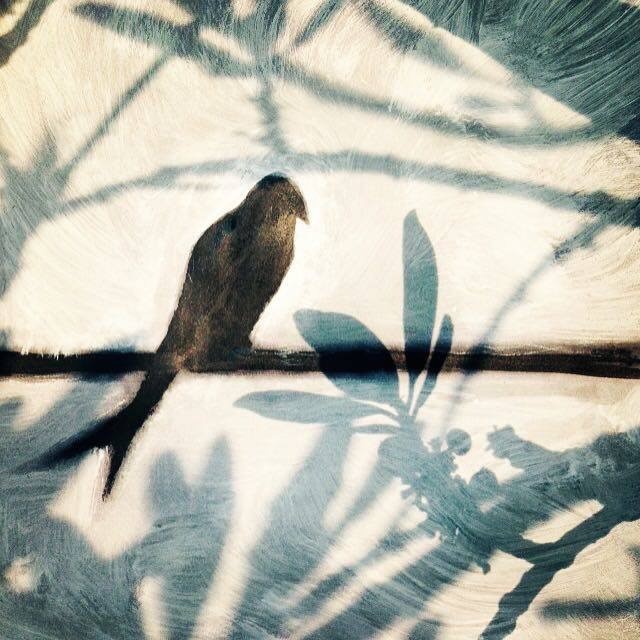At the centre of my garden stands a Bodhi tree. It was grown from a pinch of seed and soil I gathered at a Buddhist temple in Asia. This was no ordinary tree, but a direct descendant of the original Bhodi tree beneath which Siddhartha Gautama became the Buddha. Back in South Africa, a green-fingered friend took great care to nurture the seeds for me and, a few months later, presented me with a beautiful new sapling whose two leaves were the shape of tiny hearts. I have cared for the tree for nearly five years, transferring it to increasingly larger pots until, recently, I felt it was time to give her a permanent home in my garden. Now that sacred tree grows and spreads its branches more every day. She takes centre stage in my garden, marking how precious she is to me, this sacred friend.
All creatures great and small, physical and subtle, are welcome in this space and I speak to the garden every day, asking them to some closer to me. They are the body of this living temple of greenery and I make daily offerings of sweet hibiscus tea, fruit and seeds as gifts. Together, the tree and these offerings form a sacred temple of peaceful contemplation, alive with birdsong and the joyful presence of the subtle world.
There is quiet magic in listening to their conversations, a silent crescendo of communion with the Earth Mother. I tend to this garden as a sacred sanctuary and it brings me a simple peace. This is the place where I can watch the seasons unfolding and reflect on how they mirror the seasons within me: Summer, winter, spring and autumn, each a turning of the wheel in the greater dance of my own life path. It is a place where Nature is placed on a pedestal, where She is invited to thrive, to unfold, to offer her living sutras in the cycles of the seasons.
In contrast to this garden space of remembrance is the outside world, where we live in an era of collective forgetfulness. Our eyes, which were once so finely attuned to the presence of the living Mother, have become dulled into seeing the earth as an objective thing. We have removed the sacred from the earth, forgotten the nature spirits, lost touch with the natural rhythms of life and it is evident in our collective ecological crisis. To me it is important, now more than ever, to return to the natural sacredness of Nature, to look towards Her as the teacher and to surrender our relentless pursuit of spiritual awakening to acts of service to the great Mother. This is not a time for the outward evolution of humanity, but a time to step inside and hold a space of love for the Mother Earth who has been so damaged by an era of masculine domination over Her body. This is why the garden itself is my temple. It is a temple made of Her flesh, in service to Her unfolding, a place where I can intentionally hold a space of love for Mother Earth. And so the Bhodi tree is a symbol of this anchoring, of this rooting of the spiritual path in her flesh, of making a place where she is simply allowed to be, without expectation.
Nature is a teacher. She is the embodiment of the Tao, she is the silent feminine who initiates us into the deeper, unseen aspects of the spiritual path. This garden is a place of in-scendence rather than transcendence, a place where our spiritual life is taken back, deep into the source of creation beyond the words, teachings and beliefs of the masculine spiritual path that seeks always to reach outward, upward. But She turns ever inward, She is life force expressed as a circle, concentric spirals of rising and descending energies that weave a magic between soil and sky. And in some way, the planting of the Bhodi tree in a temple dedicated to the Earth Mother is a ritual act of giving the Bhodi tree history back into the earth, back to its source, returning the masculine tradition to the depths of the feminine, to reach downward and inward where it can be renewed.
I imagine the roots of this Bodhi tree reaching deeper into the soil, as the energy wrought from the sun is imbibed into its growing. It is the feminine wisdom that gently weaves connections through mycelium, subtly and silently communicating, sharing wisdom from the older trees. In the soil, she invokes the wisdom of interconnectedness, the silent dance of light through the cycles of time. She stands as a living mnemonic of the Buddha, embracing the teachings of one of the great masters of this world, but her roots are now like prayers reaching into the earth and weaving the golden thread that binds all of life in the slow, turning spiral of creation. She is the embodiment of this grand mystery of life playing itself out. And, as summer concedes to winter’s downward pull, so her leaves fall down into the dark soil and her life force retreats inward. I imagine her reaching back through the layers of time, her roots entwining with those of the mother tree from which she descended and then further back in time to the origins of all life. This is an ancient thread, a silsila of nature’s wisdom that precedes humanity, a living thread that is alive and sentient, a holy return to the source of what is sacred and pure.
Sitting in silence with this living green being, I watch with the eye of the heart how this young tree teaches in the quiet language of Nature, her sutras written in roots and leaves, in the gentle meandering touching of branch to sky. And, as she ventures into the dark depths of the soil, I see with the inner eye how she reclaims the ancient light, the long-stored breath of the sun, absorbed by the soil over centuries. She sinks her roots deeper every day, drawing this living sunlight from the underworld and bringing it back into the leaves, returning the light to the sky. And now, as the bright god of the sun begins its northern journey, leaving our southern skies to the long shadows of winter, I sit in quiet reverence, watching his retreat and the slow, rising breath of winter. Like the tree, it is a time for me to reach deeper, into silence, into my own roots, to retrieve the light that is hidden in my own fertile depths, to return to the depths of the feminine.
The tree points me to the goddess of winter who is a teacher too. I watch her slow, imperceptible dancing in an ancient ritual that has unfolded in nature since time began. That patch of garden grows colder each day, as she claims the shadows, her reach stretching ever broader, reclaiming the fruits of summer and drawing them back into the depths. She opens the doorway, revealing the underworld closer, inviting us to peer into the fertile darkness from which all life arises, weaving the outer with the inner. She shows me how the return of winter is the same journey of the soul, rejoicing in its own slow descent into the depths and how this is a transformation that we can deeply witness through her stillness and darkness. She carries the memory of countless aeons, her wisdom written in the dark weave of forest soil. She knows that sometimes the way forward is first to fall down — that growth is not only an upward reach toward the sky, but also a deep, anchoring descent into the body of the Earth. There is deep wisdom in the Earth.
The Bodhi tree knows this ancient dance of growth and retreat that the goddess of winter brings. She is intimately woven into the lineage of generations of trees from which she descended, a living thread in the forest of deep, dreaming roots that have made their way into the soil for millennia. She was witness to the flowering of consciousness beneath her great grandmother’s branches and in some way I believe that she held this space for the process of his transmutation. Sharing her wisdom with Gautama, holding the space in which he was taken to that perfect unfolding of the Golden Flower of consciousness inside his own depths. The Bodhi tree whispers her invitation to turn inward. ‘Come in,’ she gestures. ‘It’s time to surrender to the ancient feminine source, for without this letting go, there can be no renewal’.
Then the rain begins to fall again — a soft, misty autumn rain, saturating the earth. This beautiful tree becomes the empty chalice that seeks His nourishment, an empty vessel for the sky’s long exhale. She knows what to do, graciously succumbing to the downward pull, her roots spreading into the dark, fertile underworld. Everything is a holy balancing of restoration, a testament to the cyclical nature of life, a reminder to always surrender to the silence within, to reach deeper, to go to the source where the light enters the world and consciousness blooms.
I sit here, watching the majesty of creation unfolding and seeing how, in this autumn garden, the Bhodi tree turns the sun’s light inward. I see how this is the ancient Taoist turning of the light, turning the eye of the heart inward with the descending breath. The tree reminds me of the quiet living stream of feminine wisdom that is always hidden within. And it always points back to the heart. Then I see it. Beyond the form of this tree, this garden, beyond the constructs, there is an even deeper stillness pointing to a perfectly still mind. I see how it is Her mind reflected in every unfolding leaf, every spiralling root. I see how it is Her mind that shapes all of creation. This is the unity, the sacred blossoming of the Golden Flower and it is Her gift on this drizzling Autumn day.




